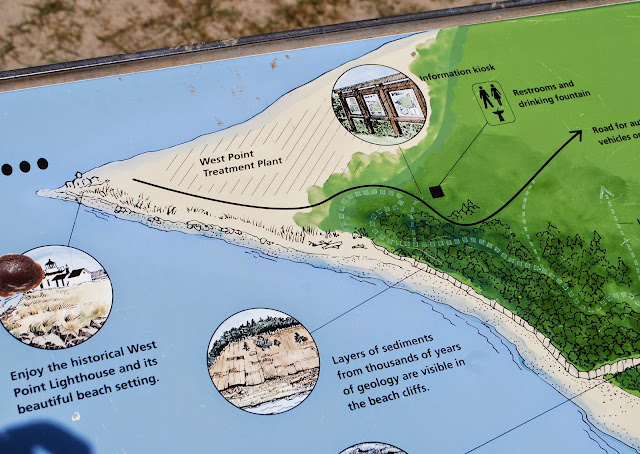In the morning, we went for about a four mile hike in Discovery Park. I'll let Annabelle tell you about it. ...
For my geology assignment, I went down to Discovery Park's south beach. I chose this location because I have walked the south beach many times, but have never stopped to examine the rocks. My assignment was done on May 9 at 10:30 AM, at a latitude of 47:39:29.11 and a longitude of 122:25:34.28, with clear blue skies and a temperature at around 73 degrees Fahrenheit.
The colors consisted of a rusty red, orange, brown, tan and other warm colors.
The cliff seemed to be sedimentary, cold, malleable, and wet to the touch.
Some sections of the cliff had been broken off. Another section had moss growing up to just above my waist height.
This photo gives you an idea of the height of the cliff.
Later in the afternoon, we went to another beach. I'll let CJ tell you about it ...
I went to a historic rock called Four Mile Rock. It's located off Perkins Lane, at the base of the Magnolia Bluff, in Seattle.
Its GPS coordinates are: 47°38′20″N 122°24′48″W. Above is a photo of it, looking toward the south.
Below, is looking to the southeast (toward Mt. Rainier).
In reading resources online, there are different opinions as to whether Four Mile Rock was contained within the Vashon Till (and deposited over 10,000 years ago), or if it is/was "a true erratic," which was up on the bluff overlooking this beach for thousands of years, and fell to its current location as the bluff eroded over time.
On the day I visited, it was May 9th, 2015. It was 73° Fahrenheit (22.7778° Celsius), with nearly clear blue skies. Four Mile Rock is approximately 20 feet across, and about 15 feet high. Many Native Americans observed the Four Mile Rock. According to Wikipedia, they called the rock LE'plEpL and Tele'tla.
Much of it is covered in barnacles, so it was difficult to see the rock beneath under the high tide line.

I used a telephoto lens to try to look at the top of the rock, which is barnacle free. I could see, from a distance, fissures and fractures, and different textures and colors.
Parts of the surface appear cracked and craggy, with some sharp edges and flaking.
Other surfaces appear smoother.
I hope to return to the rock, next time with a ladder, to get a closer look at the unobscured material.
ASTRONAUT ENCOUNTER: Saturday afternoon, we also managed to squeeze in a one hour visit to Pacific Science Center to see retired NASA astronaut Dr. Patrick Nichols talk about the past, present and future of space travel.
I'll let CJ and Annabelle let you know a little bit more about that experience.
CJ's notes first ...
On May 9, 2015, we went to the Pacific Science Center for their Astronomy Day celebration, and saw a presentation by Nicholas Patrick, a former NASA astronaut who flew on the STS-116 Discovery mission and the STS-130 Endeavor mission.
Nicholas Patrick explained to the audience about certain machines used to train astronauts for their (potentially) upcoming spaceflight. These included the Northrop T-38 Talon, an airplane which Nicholas Patrick had to fly. Nicholas Patrick told the audience that while piloting the T-38, he had to wear an oxygen mask and receive commands from mission control, which he said was good training for being on a Space Shuttle.
Dr. Patrick also said that he got in the infamous Vomit Comet for preparing him and his fellow astronauts for what it would be like to feel weightless. Dr. Patrick said that a good idea was to cling on to the floor, because you would get thrashed around and eventually feel 2Gs of falling force, which he said was actually like an 8-foot fall, but feels like a 16-foot fall. Dr. Patrick also told us about the Neutral Buoyancy Laboratory, in which he did an EVA simulation on a life-size model of the ISS.
Afterwards, Dr. Patrick told us about the future of spaceflight. He mentioned that currently, he works for a company based in Kent called Blue Origin, which recently had a test launch in west Texas, which he showed us the video of, which is available on their website at www.blueorigin.com. Dr. Patrick also mentioned that Scott Kelly's one-year mission on the ISS will certainly help figure out what might happen to astronauts on missions to Mars, which may require prolonged periods of time in space.And here's what Annabelle has to say ...
On May 9, I went to go see Dr. Nicholas Patrick at the Pacific Science Center. During the talk he gave, he talked about the past, present, and future of space. Dr. Patrick was picked by NASA as an astronaut candidate in June of 1998, and started his training in August of the same year. He was on two space shuttles, one being on STS-116, Discovery, and the other being STS-130, Endeavor. He is currently working with a company called Blue Origin, whose website you can visit at https://www.blueorigin.com/. He even showed us a developmental flight test of Blue Origin, stating that we were one of the first people to see it. The talk was very interesting and I would like to see more of Dr. Patrick's work in the future.The video of Blue Origin's recent, successful test flight is really worth seeing.
SUNDAY FUNDAY: For Mother's Day, we spent a lovely afternoon at Safeco Field.
"King" Felix Hernandez was pitching, and he and the crew got the job done, beating the Oakland A's for the third game in a row. Sweet sweep!





















No comments:
Post a Comment